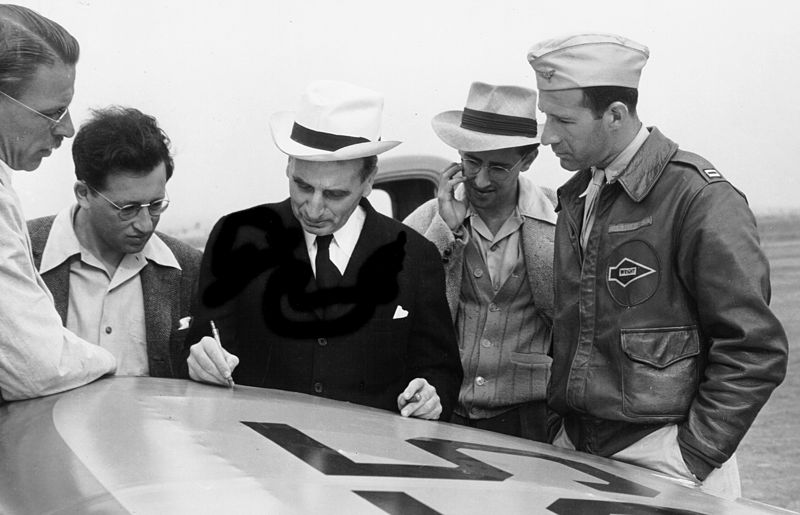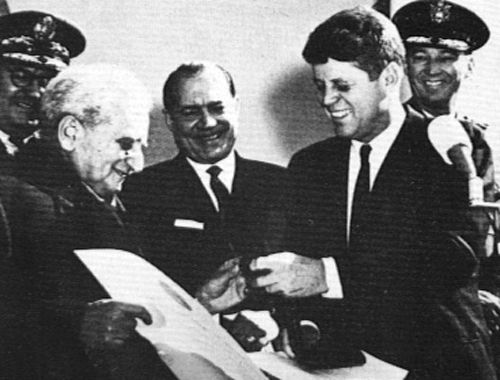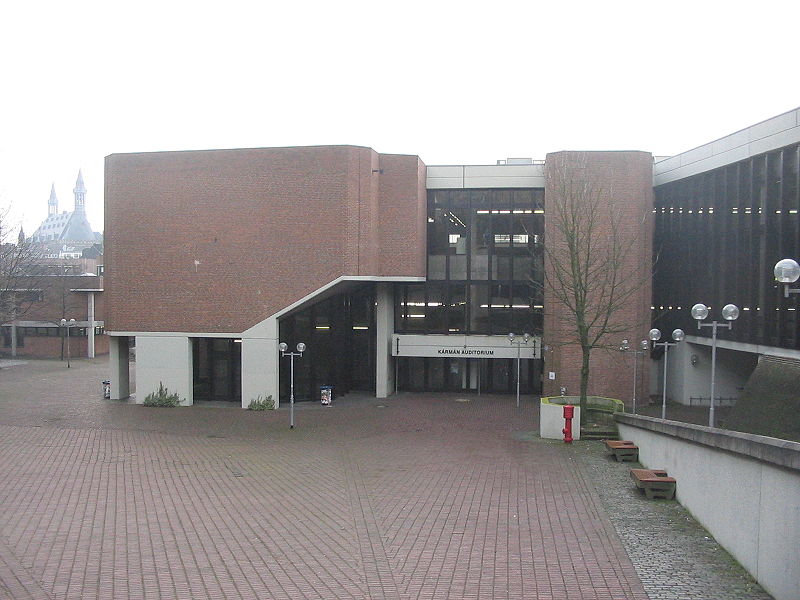Theodore
von Kármán (Hungarian: Szo"llo"skislaki
Kármán Tódor; May 11, 1881 –
May 6, 1963) was a Hungarian-American mathematician, aerospace
engineer and physicist who was active primarily in the
fields of aeronautics and astronautics. He is responsible
for many key advances in aerodynamics, notably his work
on supersonic and hypersonic airflow characterization.
He is regarded as the outstanding aerodynamic theoretician
of the twentieth century.
Early
life
Von
Kármán was born into a Jewish family in
Budapest, Austria-Hungary as Kármán Tódor.
One of his ancestors was Rabbi Judah Loew ben Bezalel.
He studied engineering at the city's Royal Joseph Technical
University, known today as Budapest University of Technology
and Economics. After graduating in 1902, he moved to Germany
and joined Ludwig Prandtl at the University of Göttingen,
and received his doctorate in 1908. He taught at Göttingen
for four years. In 1912, he accepted a position as director
of the Aeronautical Institute at RWTH Aachen, one of the
country's leading universities. His time at RWTH Aachen
was interrupted by service in the Austro-Hungarian Army
1915–1918, where he designed an early helicopter.
He is believed to have founded the International Union
of Theoretical and Applied Mechanics in September 1922
by organizing its first conference in Innsbruck. He left
RWTH Aachen in 1930.
Emigration
and JPL
Apprehensive
about developments in Europe, in 1930 he accepted the
directorship of the Guggenheim Aeronautical Laboratory
at the California Institute of Technology (GALCIT) and
migrated to the United States. In 1936, along with Frank
Malina and Jack Parsons, he founded a company Aerojet
to manufacture JATO rocket motors. He later became a naturalized
citizen of the United States.
He
later became an important figure in supersonic motion.
Noting in a seminal paper that aeronautical engineers
were "pounding hard on the closed door leading into
the field of supersonic motion."

Von
Kármán (center) during his work at the NASA
Jet Propulsion Laboratory in 1940
German
activity during World War II increased U.S. military interest
in rocket research. During the early part of 1943, the
Experimental Engineering Division of the United States
Army Air Forces Material Command forwarded to von Kármán
reports from British intelligence sources describing German
rockets capable of reaching more than 100 miles (160 km).
In a letter dated 2 August 1943, von Kármán
provided the Army with his analysis of and comments on
the German program.
In
1944, he and others affiliated with GALCIT founded the
Jet Propulsion Laboratory (JPL), which is now a Federally
funded research and development center managed and operated
by Caltech under a contract from NASA. In 1946, he became
the first chairman of the Scientific Advisory Group which
studied aeronautical technologies for the United States
Army Air Forces. He also helped found AGARD, the NATO
aerodynamics research oversight group (1951), the International
Council of the Aeronautical Sciences (1956), the International
Academy of Astronautics (1960), and the Von Karman Institute
for Fluid Dynamics in Brussels (1956).
Last
years
In
June 1944, von Kármán underwent surgery
for intestinal cancer in New York City. The surgery caused
two hernias, and von Kármán's recovery was
slow. Early in September, while still in New York, he
met with U.S. Army Air Forces Commanding General Henry
H. Arnold on a runway at LaGuardia Airport. Hap Arnold
then proposed that von Kármán move to Washington,
D.C. to lead the Scientific Advisory Group and become
a long-range planning consultant to the military. He returned
to Pasadena around mid-September. Von Kármán
was appointed to the position on October 23, 1944, and
left Caltech in December 1944.
At
age 81, von Kármán was the recipient of
the first National Medal of Science, bestowed in a White
House ceremony by President John F. Kennedy. He was recognized,
"For his leadership in the science and engineering
basic to aeronautics; for his effective teaching and related
contributions in many fields of mechanics, for his distinguished
counsel to the Armed Services, and for his promoting international
cooperation in science and engineering."

President
Kennedy honors Dr. von Kármán.
While
on a trip to Aachen (Germany) in 1963, von Kármán
died. He was buried in Pasadena, California. He never
married.
Von
Kármán's fame was in the use of mathematical
tools to study fluid flow, and the interpretation of those
results to guide practical designs. He was instrumental
in recognizing the importance of the swept-back wings
that are ubiquitous in modern jet aircraft.

The
"Kármán-Auditorium" at the RWTH
Aachen University in Germany
Selected
Contributions
Specific
contributions include theories of non-elastic buckling,
unsteady wakes in circum-cylinder flow, stability of laminar
flow, turbulence, airfoils in steady and unsteady flow,
boundary layers, and supersonic aerodynamics. He made
additional contributions in other fields, including elasticity,
vibration, heat transfer, and crystallography. His name
also appears in a number of concepts, for example:
• Föppl–von Kármán equations
(large deflection of elastic plates)
• Born-von Kármán lattice model (crystallography)
• Chaplygin-Kármán-Tsien approximation
(potential flow)
• Falkowich-Kármán equation (transonic
flow)
• von Kármán constant (wall turbulence)
• Kármán line (aerodynamics/astronautics)
• von Kármán–Gabrielli diagram
(transportation)
• Kármán-Howarth equation (turbulence)
• Kármán-Nikuradse correlation (viscous
flow; coauthored by Johann Nikuradse)
• Kármán-Pohlhausen parameter (boundary
layers)
• Kármán-Treffz transformation (airfoil
theory)
• Prandtl-von Kármán law (velocity
in open channel flow)
• von Kármán integral equation (boundary
layers)
• von Kármán ogive (supersonic aerodynamics)
• von Kármán vortex street (flow past
cylinder)
• von Kármán-Tsien compressibility
correction.
• Vortex shedding
Selected
writings
• Aerodynamics - Selected Topics in the Light of
their Historical Development, Cornell University Press,
Ithaca, 1954
• Collected Works, (4 Volumes), Von Karman Institute,
Rhode St. Genese, 1975 (limited edition book); also Butterworth
Scientific Publ., London 1956. Many papers from volumes
1 and 2 are in German.
• From Low Speed Aerodynamics to Astronautics, Pergamon
Press, London, 1961
• The Wind and Beyond - Theodore von Kármán
Pioneer in Aviation and Pathfinder in Space, Little Brown,
1967 (with L. Edson)
• Mathematical Methods in Engineering, McGraw Hill,
1940 (with M. A. Biot)
Honors
and legacy
•
Each year since 1960 the American Society of Civil Engineers
has awarded to an individual the Theodore von Karman Medal,
"in recognition of distinguished achievement in engineering
mechanics."
• In 2005, von Kármán was named an
Honorary Fellow of the Arnold Engineering Development
Center (AEDC). Fellows of the AEDC are recognized as,
"People who have made exceptionally distinguished
contributions to the center's flight testing mission."
• Craters on Mars and the Moon are named in his honor.
• The boundary between the atmosphere and space is
named the Kármán Line
• In Irvine, CA there is a 5-mile street that runs
through the heart of Irvine's business center named after
him.
• In 1977, RWTH Aachen University named its newly
constructed lecture hall complex "Kármán-Auditorium"
in memory of von Kármán's outstanding research
contributions at the university's Aeronautical Institute.
• An auditorium at JPL is named after von Kármán.
• University of Southern California Professor Shirley
Thomas (after nearly two decades of petitioning) was able
to create a postage stamp in his honor.[13] It was first
issued in 1992 with his image as an "Aerospace Scientist".
• In 1956, von Kármán founded a research
institute in Sint-Genesius-Rode, Belgium, which is now
named after him: the von Karman Institute for Fluid Dynamics.
• In 1948, von Kármán was awarded the
Franklin Medal.
Source:
http://en.wikipedia.org/wiki/Theodore_von_K%C3%A1rm%C3%A1n
